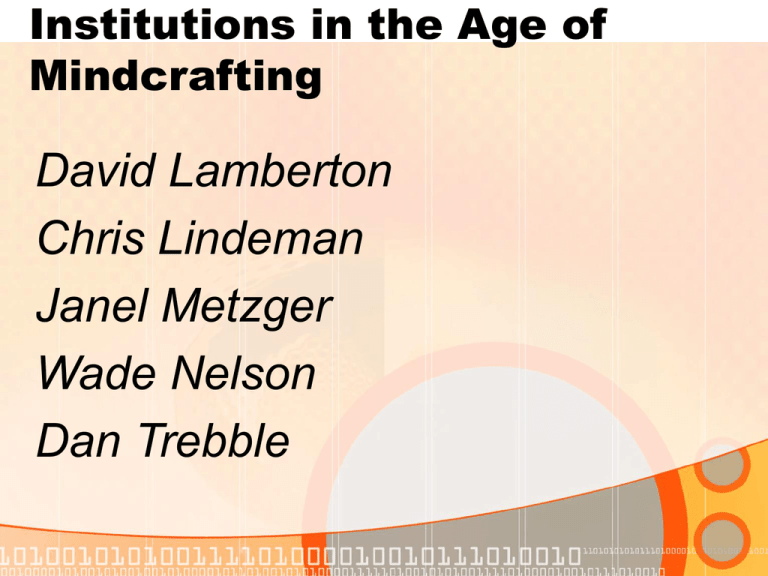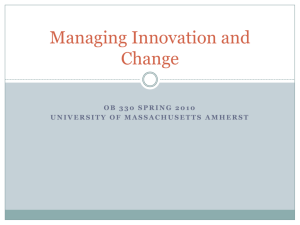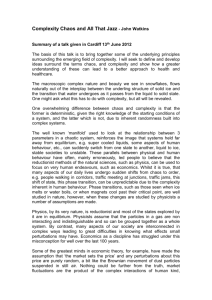David Lamberton Chris Lindeman Janel Metzger Wade Nelson
advertisement

Institutions in the Age of Mindcrafting David Lamberton Chris Lindeman Janel Metzger Wade Nelson Dan Trebble Institutions in the Age of Mindcrafting Overview • History of organizations • Why this is important • Three Universal Laws about why organizations are outdated • Chaos with order History of Organizations • Newtonian science is the father • Stating every action has an equal and opposite reaction • Gave rise to machine metaphor History of Organizations • Industrial Revolution is mother • Enforced conformity and routine behaviour • Centralized authority created a class of managers • At present, the Universities have a monopoly on managers Why This is Important • All the “re”’s that are now so popular – reorganize, reengineering, reinventing are incorrect • Implies that one just needs a new version of what already exists • The need to reconceive organization Three Universal Laws Law # 1 Everything has consequences Law # 2 Simple is intelligent Law # 3 Co-operation and competition are equally valuable Law #1 • Everything, has both intended and unintended consequences. The intended consequences may or may not happen; the unintended ones always do. Law #1 • Implies obvious unintended results • We call them accidents • In organizations it is difficult to predict the outcome of an action History of the Charge Card • 1966 Bank of America launched BankAmericard • In response, 5 banks in California launched MasterCharge • 1968 operating, credit and fraud losses were believed to be in the tens of millions of dollars History of the Charge Card • Infant industry was out of control • Formed a committee of six to come up with a solution • Realized traditional structures could not work Law #2 • Simple, clear purposes and principles give rise to complex, intelligent behaviour. Complex rules and regulations give rise to simple, stupid behaviour. • Control stifles ingenuity Law #2 • • • • Classic versus Modern art Everyone can tell what it is, no question Modern left up to interpretation One gets a sense that it was painted for them and each interpretation is different Law #2 Law #3 • Everything is its opposite –particularly competition and co-operation. Neither can rise to its highest potential unless both are seamlessly blended. Either without the other swiftly becomes dangerous and destructive. Law #3 • Ying Yang – opposite in every way • Together they create a symbol known worldwide • Apart they are meaningless shapes The Three Laws • These laws suggest something that the modern organization does not have – chaos with order • Uninhibited, unbound thought directed at a goal Chaos with Order Chaord – any self-organizing, adaptive, non-linear, complex community or system, whether physical, biological or social, the behaviour of which exhibits characteristics of both order and chaos; any chaotically ordered complex. Chaos with Order • Organizations are currently downward looking in regards to management • That perception is wrong • • • • Manage one’s self Manage those who have authority over us Manage peers Manage those over whom we have authority A Look Back at VISA • Unstructured organization • No political, economic, social or legal theory • Can therefore transcend language, customs, politics and culture A Look Back at VISA • Successfully connects institutions and people of every persuasion • Has multiple boards of directors within a single legal entity • No one entity can be considered superior or inferior and each has authority and autonomy over geographic areas “The nature of our modern management phenomenon is the creation and control of constants, uniformity and efficiency” BUT “The need has shifted to understand and co-ordinate variability, complexity, and effectiveness” “We need to address the fact that organizational structures of the industrial revolution, of conformity, are outdated and need changing so the knowledge workers have chances to use their knowledge and ingenuity” “We think that with more hierarchical command and control, we could pull a lever at one end and get a precise result at the other end, and know with certainty which lever to pull for which result” “Never mind that human beings must be made to work like cogs and wheels in the process” “Without question, the most abundant, least expensive, most underutilized and frequently abused resource in the world today is human ingenuity” “It is leadership this world so badly needs, and so-called “scientific management” it so sadly gets” “Given the right circumstances, from no more than dreams, determination and the liberty to try, quite ordinary people consistently do extraordinary things.” Question Do you think that this organizational structure would be effective in a University setting; self or group teaching and no professor to be accountable to?




